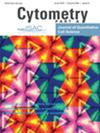下载PDF
{"title":"FATT-CTL assay for detection of antigen-specific cell-mediated cytotoxicity†","authors":"Carel A. van Baalen, Rob A. Gruters, Eufemia G. M. Berkhoff, Albert D. M. E. Osterhaus, Guus F. Rimmelzwaan","doi":"10.1002/cyto.a.20613","DOIUrl":null,"url":null,"abstract":"<p>Here we describe a flowcytometric assay that measures the defining function of virus-specific cytotoxic T lymphocytes (CTL), i.e., killing viral protein expressing cells. The fluorescent antigen-transfected target cell (FATT)-CTL assay requires no viruses, recombinant viral vectors, or radioactive isotopes to generate CTL target cells that present naturally processed epitopes. It facilitates developing standardized applications in clinical trial settings. Plasmid vectors encoding antigen-green fluorescent protein (GFP) fusion proteins were used directly to nucleofect immortalized B cells or peripheral blood mononuclear cells (PBMCs). Elimination of antigen-GFP expressing cells by cloned CTL, in vitro sensitized PBMC, or ex vivo PBMC was quantified following a 4–18-h coculture period by flowcytometry. This technology successfully detected cell-mediated cytotoxicity in studies involving human PBMC and various viral antigens, including structural proteins of influenza A virus, and structural and nonstructural HIV proteins. Standardized protocols are currently being developed in the framework of a clinical immunotherapy trial in HIV-infected individuals. The FATT-CTL assay principles facilitate standardized flowcytometric detection of antigenic protein-specific cell-mediated cytotoxicity in many different basic research and clinical trial settings. By measuring their defining function, the FATT-CTL assay contributes to a more complete assessment of antigen-specific CTL responses to infection and vaccination. © 2008 International Society for Advancement of Cytometry</p>","PeriodicalId":11068,"journal":{"name":"Cytometry Part A","volume":"73A 11","pages":"1058-1065"},"PeriodicalIF":2.5000,"publicationDate":"2008-10-22","publicationTypes":"Journal Article","fieldsOfStudy":null,"isOpenAccess":false,"openAccessPdf":"https://sci-hub-pdf.com/10.1002/cyto.a.20613","citationCount":"19","resultStr":null,"platform":"Semanticscholar","paperid":null,"PeriodicalName":"Cytometry Part A","FirstCategoryId":"99","ListUrlMain":"https://onlinelibrary.wiley.com/doi/10.1002/cyto.a.20613","RegionNum":4,"RegionCategory":"生物学","ArticlePicture":[],"TitleCN":null,"AbstractTextCN":null,"PMCID":null,"EPubDate":"","PubModel":"","JCR":"Q3","JCRName":"BIOCHEMICAL RESEARCH METHODS","Score":null,"Total":0}
引用次数: 19
引用
批量引用
Abstract
Here we describe a flowcytometric assay that measures the defining function of virus-specific cytotoxic T lymphocytes (CTL), i.e., killing viral protein expressing cells. The fluorescent antigen-transfected target cell (FATT)-CTL assay requires no viruses, recombinant viral vectors, or radioactive isotopes to generate CTL target cells that present naturally processed epitopes. It facilitates developing standardized applications in clinical trial settings. Plasmid vectors encoding antigen-green fluorescent protein (GFP) fusion proteins were used directly to nucleofect immortalized B cells or peripheral blood mononuclear cells (PBMCs). Elimination of antigen-GFP expressing cells by cloned CTL, in vitro sensitized PBMC, or ex vivo PBMC was quantified following a 4–18-h coculture period by flowcytometry. This technology successfully detected cell-mediated cytotoxicity in studies involving human PBMC and various viral antigens, including structural proteins of influenza A virus, and structural and nonstructural HIV proteins. Standardized protocols are currently being developed in the framework of a clinical immunotherapy trial in HIV-infected individuals. The FATT-CTL assay principles facilitate standardized flowcytometric detection of antigenic protein-specific cell-mediated cytotoxicity in many different basic research and clinical trial settings. By measuring their defining function, the FATT-CTL assay contributes to a more complete assessment of antigen-specific CTL responses to infection and vaccination. © 2008 International Society for Advancement of Cytometry
fat - ctl法检测抗原特异性细胞介导的细胞毒性
在这里,我们描述了一种流式细胞术,测量病毒特异性细胞毒性T淋巴细胞(CTL)的定义功能,即杀死表达病毒蛋白的细胞。荧光抗原转染靶细胞(FATT)-CTL测定不需要病毒、重组病毒载体或放射性同位素来产生呈现自然加工表位的CTL靶细胞。它有助于在临床试验环境中开发标准化应用程序。利用编码抗原-绿色荧光蛋白(GFP)融合蛋白的质粒载体直接对永生化B细胞或外周血单核细胞(PBMCs)进行核效应。在共培养4 - 18小时后,用流式细胞术量化克隆CTL、体外增敏PBMC或离体PBMC对表达抗原gfp的细胞的消除作用。该技术在涉及人PBMC和各种病毒抗原的研究中成功检测了细胞介导的细胞毒性,包括甲型流感病毒的结构蛋白,以及结构和非结构HIV蛋白。目前正在艾滋病毒感染者的临床免疫治疗试验框架内制定标准化规程。fat - ctl测定原理有助于在许多不同的基础研究和临床试验环境中对抗原蛋白特异性细胞介导的细胞毒性进行标准化的流式细胞术检测。通过测量它们的定义功能,fat -CTL测定有助于更完整地评估抗原特异性CTL对感染和疫苗接种的反应。©2008国际细胞术进步学会
本文章由计算机程序翻译,如有差异,请以英文原文为准。



